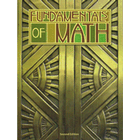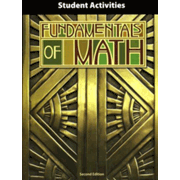This BJU Press math text, intended for seventh grade, addresses the national math standards while balancing it with solid review of foundational arithmetic skills. The two-volume teacher's edition provides lesson introductions, explanations, and enhancements that should be presented by the teacher, so this course really should be "taught" rather than used for independent study. However, the second edition has added many examples and "skill checks" to each lesson presentation so students could work through lessons independently for the most part if they don't need the conceptual explanations, additional practice, or other "teacher-directed" learning. Still, sometimes a key concept or piece of information only appears in the teacher's edition and must be presented to the student by some means. The enhancements to the new edition (as well as the inclusion of topics not in the first edition) have increased the size of the student text from 479 pages to 676. Some of the topics that appear in this edition that were not taught in the first edition are probability and statistics, surface area and volume of circular cylinders, solving inequalities, functions with ordered pairs, graphing linear functions, slope, and transformations. This reflects the general increase in difficulty (or what might be called the advanced progression) of math texts in general in the U.S. over the last few decades.
The full-color student text is a softbound worktext in a large, 8.5" x 11" format. While there is a great deal of material in the book, the larger format keeps pages from appearing crowded or overwhelming.
Fundamentals of Math has a very clear Christian perspective. Chapters open with some sort of connection between Scripture or faith and mathematics. A "Math and Scripture" page in each chapter directs students to Scripture for research and investigation that involves math. Other religious references show up in many places such as the references to Moses and the dimensions of the Ark of the Covenant in the examples and practice problems for teaching about mixed numbers and improper fractions (p. 149).
In addition, each chapter includes an inspiring biographical sketch on either a biblical or secular person, demonstrating some connection to math. For example, from the secular side, in the first chapter students encounter Charles Lindbergh, praised for his perseverance and courage in both his aviation feats and later inventions. Later they meet Werner von Braun, a key figure in the development of missiles and rocket science for Germany and the U.S. (in the introduction to algebra). Among the biblical characters are Hiram, the metal worker from 1 Kings 7:14 in the chapter on geometry, and Joshua, in the context of casting lots (Joshua 18:10) in the chapter on probability.
Chapters are broken down into subsections (about 8 to 9 subsections per chapter). Each subsection has exercises for students to complete, including a section of cumulative review questions. Even with the cumulative review in subsections, Fundamentals of Math differs from the spiral approach of Saxon Math; this text addresses a separate topic within each chapter rather than teaching new topics in increments (Saxon's approach), with those increments often separated by lessons on entirely different topics.
Arithmetic basics are reviewed in the text along with fractions, decimals, and percents. Measurements, geometry, probability, and statistics, are also reviewed then taught at a higher level. The text really shifts into prealgebra in the sections on integers ( absolute value, positive/negative numbers, the number line), the introduction to algebra, relations and functions using the coordinate plane, and logic and set theory. Practical life applications are often included, especially in the numerous word problems.
The student text has a chapter review at the end of each chapter. Answers to all exercises and chapter reviews are included in the Teacher Edition. The Teacher Edition includes a CD-ROM with visual aids and "Mathardy," a "Jeopardy" type math game--all most useful in a classroom setting.
A separate Test Packet includes quizzes, chapter tests, and cumulative tests. There is a separate answer key for the Test Packet. Both of these items are included in the homeschool kit along with the student text and Teacher Edition as well as a Student Activity Manual and a teacher guide/answer key to the Activity Manual. There are plenty of problems in the core student text, so the Activity Manual might be optional even though it's included in the homeschool kit. However, the Activity Manual does include abundant review and practice along with a Calculator Skill development exercise for every chapter, Biblical application, word problems, and cumulative reviews. Activity Manual exercises should not take a great deal of time, so I would recommend using it, even if for selective activities, for most students.
You might want to check out the premade lesson plans from Homeschool Planet that are available for BJU Press's math courses.
Find lesson plans available for this product at Homeschool Planet. Sign up for a 30-day FREE trial.












